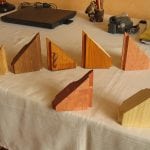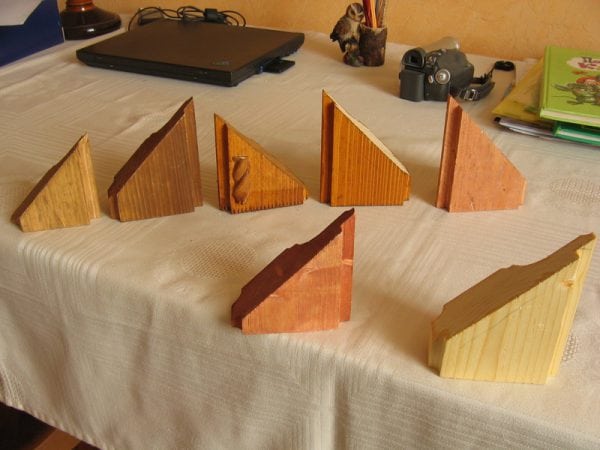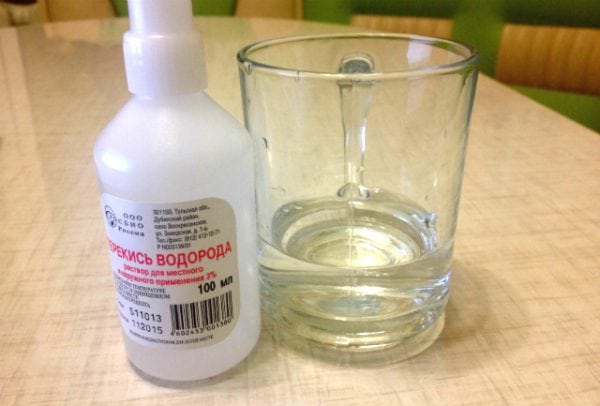Stain (another name is stain) is a tinting composition designed to change the natural color and emphasize the natural texture of wood products. The impregnating composition penetrates deep into the wood structure - much deeper than varnish, enamel or paint can penetrate. You can buy a stain in the store or make it yourself. Do-it-yourself stain can be made in accordance with the recipes specified in this article.
- Functions of stains
- Types of stains
- Water base
- Alcohol base
- Oil base
- Acrylic base
- Wax base
- Traditional recipes for the production of stains
- Vegetable stains
- Compositions based on tea, coffee and vinegar
- Chemical Based Compounds
- Whitening compounds
- Stain treatment methods
- Useful tips for craftsmen
- Potential problems

Functions of stains
Beits are used for processing not only wooden surfaces, but also fiberboard, particleboard, MDF and plywood. Modern compositions, in addition to their main purpose, have disinfecting characteristics and extend the life of wooden products. Solutions based on alkyds, oils and solvents help prevent moldiness and repel harmful insects.
Sometimes stains are used to hide the real wood species. With the help of steys, you can imitate an expensive species of wood (for example, oak) by painting them with a normal pine. In addition, by impregnation it is possible to accentuate the natural wood texture. If you use several beitzer correctly, you can combine various shades in a single artistic concept and turn a wooden product into a work of art.
to contents ↑Types of stains
Classification of stains is carried out according to the basics from which solutions are made. Usually, beits are made on the basis of water, alcohol, oil, acrylic or wax. Below we consider in more detail each of the listed basics.
Water base
Water-based stains are produced in two varieties:
- dry powder for mixing it with water;
- ready-to-use aqueous solution.
The main disadvantage of water strangers is a long drying period. Therefore, to obtain a uniform tonality of the surface, it takes a lot of time.
When using aqueous compounds, the wood fiber rises. This emphasizes the structure of the material, but makes it less resistant to moisture. To avoid such an effect, it is recommended to wet the surface of the wood and then sand it well before soaking.
to contents ↑Alcohol base
Alcohol-based whites are solutions that include ethyl alcohol, organic dyes, and pigments. Such compounds are used not only for decorative surface treatment, but also as antiseptics. As a result of treatment with alcohol solutions, the raising of the pile is reduced and the wood does not swell.
Alcohol stains do not allow to obtain uniformly painted surfaces, since such impregnations dry quickly, which leads to the formation of spots. Thus, alcohol solutions are more applicable to small objects, while for painting large surfaces this is not the best option.
to contents ↑Spray alcohol stains are applied exclusively using spray guns. Brush staining is not recommended, since it is difficult to achieve high-quality impregnation in this case.
Oil base
Oil-based impregnations provide a wide variety of shades. Such stains are made on the basis of dyes, which dissolve well in oils and varnish. The solvent element is white spirit.
It is not difficult to work with an oil stainer: it can be applied both with a brush and from a spray. Such stains do not raise wood fiber and evenly disperse on the surface.
to contents ↑Acrylic base
Acrylic-based stains are the last word in the development of tinting compositions. Thanks to acrylic, a thin color film appears on the surface. It performs not only decorative, but also protective functions, limiting excessive wetting of the material. Acrylic compounds dry quickly, are free from unpleasant odors, safe and can be used for processing any kind of wood.
When treating a surface with an acrylic stain, you need not get carried away with a large number of layers. A couple of layers are usually enough. If you overdo it, stains will remain on the wooden product.
to contents ↑Wax base
As well as acrylic stains, wax impregnations form decorative protective films. Typically, such compositions are used together with surface polishing. Wax stain is applied with a soft cloth.
Note! Wax stains should not be used if it is planned to treat the wood with two-component acid-cured varnishes or polyurethane paints.
Traditional recipes for the production of stains
Making stains can be mastered at home. The compositions can be made in several ways:
- from plant materials;
- from tea, coffee or vinegar;
- from chemical constituents.
You can also make a bleaching composition. We will dwell on the technology for the production of wood stains in more detail below.
to contents ↑Vegetable stains
The following are recipes for plant-based Beites:
- Decoction of larch bark. Gives the tree a red tint. Birch wood will look especially beautiful.
- A reddish hue also attaches to the husks of onions. It is customary to process light woods with such a decoction.
- You can get impregnation from the walnut shell, which will give the tree a brown tint. To prepare the impregnation, you need to grind the shell into powder. The dried powder is boiled in water and filtered through a sieve. Next, soda is added to the solution. If you add potassium dichromate, wood to the solution will get a reddish tint. In order to get a gray tint, acetic acid is applied to the already treated surface.
- Black coloring can be achieved by treating the tree with a decoction of oak and alder bark.
- Also black color can be obtained due to the decoction of the willow bark and alder.
- A uniform brown color is obtained due to the solution, in which equal amounts of walnut shells, alder earrings, as well as oak and willow bark are added. The components are poured into water, which is brought to a boil. After that, half a teaspoon of soda is added, and the solution boils for another 10 minutes.
- A brownish tint will give the product a decoction of walnut shells and apple tree bark.
- Wood will get a golden hue after processing with a decoction of buckthorn berries.
Compositions based on tea, coffee and vinegar
- For the production of stains, which will give the tree a brown color, mix ground coffee with soda.
- To make light wood brown, you can use tea brewing. The color depth depends on the strength of the tea leaves.
- The effect of “ebony” can be achieved by pouring acetic acid into a container with nails and letting the solution brew for a week in a dark place.
Chemical Based Compounds
- Oak wood will turn brown if soaked with slaked lime. Walnut, in addition to brown, will acquire a slightly greenish tint.
- Cherry blossom can be conveyed to wood if a manganese solution is applied to it. To prepare it, you need to add 50 grams of potassium permanganate to a liter of warm water.
- Yellow color for light wood can be achieved by treating it with a decoction of barberry root. In the cooked broth, you need to pour alum, and then bring the liquid back to a boiling state.
- A greenish tone can be obtained by mixing 50 grams of copperfish with vinegar. Boil the solution for 15 minutes.
- If you mix wolfberries with vitriol, you get a brown tint. When mixing the same berries with glauber's salt, a scarlet color will come out. As a result of mixing wolf berries and soda, a blue tonality is obtained.
Whitening compounds
Whitening impregnations are used as a preparatory measure before painting a tree. Some types of wood get interesting shades as a result of bleaching. For example, a nut with its purple hue takes on a pale pink or scarlet color. Apple wood is ivory.
Recipes for bleaching stains:
- Oxalic acid solution. For 100 grams of water, 5 grams of acid is taken. The solution is used for bleaching light wood. On dark rocks after treatment with such a composition, stains of an unpleasant color will remain. After bleaching, the tree is washed in a solution where 3 grams of soda and 15 grams of lime are taken per 100 grams of water.
- Using a 25% hydrogen peroxide solution, almost all wood species can be bleached, with the exception of oak and rosewood. Flushing in this case is not needed.
Stain treatment methods
Stain impregnation is possible in several ways:
- Spraying with a spray gun. The method is good uniform distribution of the composition on the surface.
- Rubbing with a cloth. The method is optimal for porous wood.
- Surface treatment by roller. Used for application on small areas. When working with a roller, no stains occur, and the composition is distributed evenly.
- Brush application. This method is not applicable to all types of stains. However, the wood when processing with a brush gets especially deep shades.
Useful tips for craftsmen
Below will be given tips that will achieve better results when processing wood with wood stain:
- The composition should be applied in the direction of the texture of the material.
- Beyts is applied in 2-3 layers.
- The first layer is applied very little solution. It is necessary to wait for the surface to dry. Then it is necessary to sand it and remove the raised pile.
- The brush should not fall on already processed areas.
- Wood is polished in the direction of the fibers or obliquely.
- Significant surface areas need to be divided into sections and processed alternately.
- A new layer can be applied only after the previous one dries.
- Compositions based on water or solvent dry up to 3 hours, but oil - up to 3 days.
- Thick oil stains are diluted with paint thinners, and aqueous formulations are diluted with water.
Potential problems
Improper handling may cause drips. This happens when too much stain is applied to the surface. In such a situation, you need to remove as much excess stain as possible. To do this, you need to apply another layer of stain, and then use an cloth to remove an excessive layer of the composition. A solvent is used to remove dried impregnation. You can also use sandpaper or a plane.
Stains on wood may appear due to the uneven density of the material.On some species (for example, on a nut), the spots do not spoil the appearance, however, on coniferous wood or cherry, the spotting looks unattractive. Stains can only be removed with a planer. Stains can be prevented if gel-like stains are used. Such compositions do not spread over the surface and are absorbed for a long time, therefore, the formation of spots is unlikely.

















